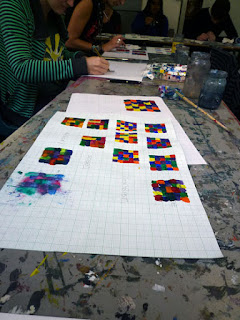The topic for "critical studies" in the morning was: Putting art in place(s): Contexts and modes of display. This involved talking about what museums and galleries are for, and what the role of the curator is. Interesting to think of
William Blake in, when, the 1780s? as an "artist curator" - arranging exhibitions of his own work - just as Damien Hirst did in the 1980s with
Freize ("hardly anyone went, but he did drag Charles Saatchi along, and he bought a lot of work").
New to me was Turner Prize winner (2004) Jeremy Deller, who controversially admitted he had no "artistic talent", but he could organise things - for example, in 2009 a
procession to celebrate Manchester's "everyday culture" - including Big Issue sellers, Goths, modified cars, and "homage to the chip" to celebrate the world's first chip shop -

see a 9-minute video
here (warning: starts with an advert).
Then it came to the matter of displaying art works - what needs to be considered. Curatorial concerns are that "all aspects of display can affect the meaning of art works" - for example,
Jeff Wall displays his photos in lightboxes, to give them an aura that separates art from the ordinary. I'm very fond of his "A Sudden Gust of Wind (after Hokusai) -

Relationships of one work to another can be important too - for example, when setting out collections thematically - fans of Monet's Water Lilies might be upset to see them displayed next to a stone circle by Richard Long...

Our task, in small groups, was to analyse how putting works together would affect their meaning and function; find a theme that links them, and give the exhibition a title; and decide what other art works might be shown with them. Here are an inflated bin bag by
Ceal Floyer, and Balloon Dog, and Moon, by Jeff Koons - our title was Inflation and referred not just to the air within the items (though the balloons are metal in the sculpture) but to the value of the art works.

Then, the politics of display, and the artist of note was
Maurizio Cattelan, memorable for his "Pope hit by Meteor" at the Royal Academy some years ago -

In regard to the "white cube" gallery as a "framing device" for art, the artist example was
Michael Asher, who alters the actual building, so that the viewer is actually entering the space of the artwork.
Land art and earth works - Robert Smithson's
Spiral Jetty, Nancy Holt's
Sun Tunnels, both from the early 1970s. And James Turrell's
Sky Spaces.
Less excitement (but rather more chaos) in the afternoon, as we continued painting our coloured squares - enlarging them.

At least we shared palettes, so rather less paint was wasted.
 This is an experiment to see what happens when an InDesign file is saved as a jpeg and used on the blog. It kinda works...
This is an experiment to see what happens when an InDesign file is saved as a jpeg and used on the blog. It kinda works... These are all in the area east of the Canal St Martin, behind the legendary Hotel du Nord - oh I have a photo of that too (what a great old film - a gripping drama of guilt made in 1938) -
These are all in the area east of the Canal St Martin, behind the legendary Hotel du Nord - oh I have a photo of that too (what a great old film - a gripping drama of guilt made in 1938) -

















































